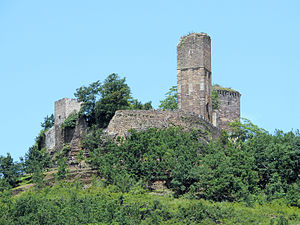Saint-Laurent-les-Tours
|
Saint-Laurent-les-Tours Sent Laurenç |
||
|---|---|---|
|
|
||
| region | Occitania | |
| Department | Lot | |
| Arrondissement | Figeac | |
| Canton | Saint-Céré | |
| Community association | Causses et Vallée de la Dordogne | |
| Coordinates | 44 ° 52 ′ N , 1 ° 54 ′ E | |
| height | 152-465 m | |
| surface | 11.33 km 2 | |
| Residents | 891 (January 1, 2017) | |
| Population density | 79 inhabitants / km 2 | |
| Post Code | 46400 | |
| INSEE code | 46273 | |
 Saint-Laurent-les-Tours - Château |
||
Saint-Laurent-les-Tours ( Occitan : Sent Laurenç ) is a municipality with 891 inhabitants (as of January 1, 2017) in the Lot department in the French region of Occitania .
location
Saint-Laurent-les-Tours is located in the northeast of the Quercy landscape, which is extremely rich in cultural and culinary attractions . The capital of the Quercy, Cahors , is approximately 83 kilometers (driving distance) to the southwest. It is about 3 kilometers south to the neighboring municipality of Saint-Céré . Loubressac and Autoire are among the “ Most Beautiful Villages in France ” and are located about 13 and 10 kilometers to the west and south-west, respectively.
Population development
| year | 1968 | 1975 | 1982 | 1990 | 1999 | 2006 |
| Residents | 394 | 531 | 747 | 835 | 900 | 907 |
history
It is possible that there was a fortress complex castrum on one of the hills nearby as early as Gallo-Roman times . According to tradition, a castle is said to have stood in the same place as early as the 8th century. In the Middle Ages, the place belonged to the property of the Turenne vice-county . During the Hundred Years War (1337-1453) the castle came into the possession of the English temporarily (1384-1390); During the Huguenot Wars (1562–1598) it was occupied by the Protestants for several years (1575–1586).
Attractions
- The impressive ruins of the castle ( château ) date from different epochs (12th to 14th centuries), the time when it belonged to the viceroy of Turenne. Two towers have been preserved. In 1895 a residential building was placed between the two medieval towers and equipped with another small tower.
- Musée Lurçat : In 1941 the artist Jean Lurçat settled in the castle; In 1945 he bought the property and kept it as a residence and work place until his death in 1966. His wife donated the complex to the Conseil Général du Lot in 1986, on condition that it be turned into a museum in her husband's memory . Today you can visit the studio, where some of the artist's paintings, ceramics and carpets are on display.
- The parish church ( Église paroissiale ), a single-nave building from the 17th century, houses a baroque altarpiece and a tabernacle - both are classified as monument historique .
Personalities
- Jean Lurçat (1892–1966), artist
